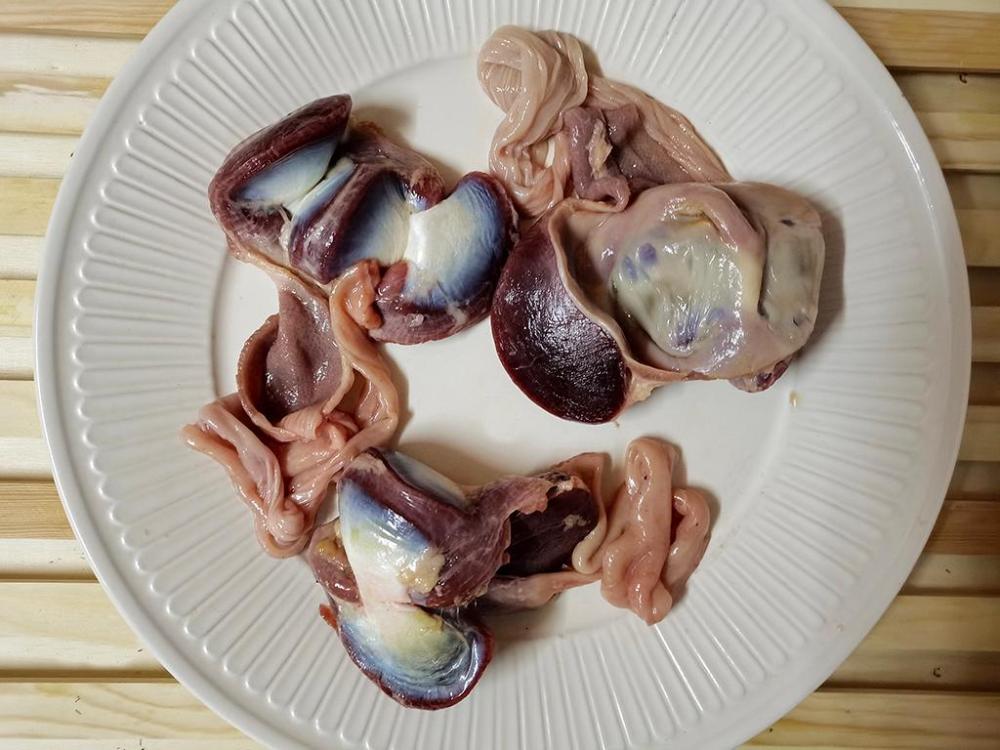In the lists of available poultry viscera, there is a notable omission from nearly all. Have you ever seen the birds’ kidneys? This invisibility has led many people to assume these birds don’t have kidneys, but that is false. They do. So where are they?
Well, for a start, poultry kidneys are not normally the usual bean shape, but elongated strings attached to either side of the backbone. They are very small compared to say, the livers and difficult to harvest from the bird. I often get them when butchering a whole duck and scrape them out as a chef’s treat. But to collect them for a meal would be tedious, so they are seldom available.
However, when I search the online shopping apps for ‘duck kidneys’ or ‘chicken kidneys‘ I get plenty of results. The problem is that what they are showing me is not kidneys, but gizzards. I’m not sure why. They look very different and have different names in Chinese, too! Kidneys are 腰 (yāo) or 肾 (shèn) while gizzards are most commonly 胗 (zhēn).
Chicken Gizzards
Gizzards have nothing to do with kidneys. In poultry, the kidneys process urine and, as birds lack bladders, pass that straight to the exit point, known as the cloaca. There is a good, non-gory diagram of a birds digestive system here.
The gizzard is the bird’s second stomach. The first stomach, the proventriculus, provides the chemical secretions needed to partially break down the food. This then passes into the gizzard, also known as the ventriculus or ‘muscular stomach’, which does the job of the teeth in other animals. As you know hen’s teeth are rare!
Duck Gizzards
The gizzard is a powerful muscle which grinds the food such as seeds. If in need of more chemical treatment, the food can be passed back to the proventriculus for another dose of chemical action. In order to help the gizzard grind the food, many, but not all, birds also swallow grit and small stones, known as gastroliths, for their abrasive qualities. Most poultry birds do so. Remember this when preparing gizzards for the table. You don’t want to break a tooth on a gastrolith.
Incidentally, gizzards are not only found in birds. Crocodiles and alligators have them, as do some fish and crustaceans. Earthworms are 99% gizzard!
Gizzards are eaten as widely around the world as poultry livers, if not more so. In SE Asia, they are often grilled and sold in night street markets, In fact, the last time I ate any was in Vietnam.
They are eaten across Europe. In France, duck gizzards are eaten in a traditional salad, along with walnuts, croutons and lettuce. Portugal stews them in fresh tomato sauce, while Spain cooks them on the plancha grill.
Across Africa, gizzards are prized, usually grilled or fried.
The USA also likes a good gizzard, especially, I’m told, in the southern states. According to Wikipedia,
QuotePickled turkey gizzards are a traditional food in some parts of the Midwestern United States. In Chicago, gizzard is battered, deep fried and served with French fries and sauce. In the Southern United States, the gizzard is typically served fried, sometimes eaten with hot sauce or honey mustard, or added to crawfish boil along with crawfish sauce, and it is also used in traditional New Orleans gumbo.
True?
Mexico serves chicken gizzards with beans and tortillas for breakfast.
But I think it is in Asia that they are most appreciated and are used in most ways.
Here in Mainland China, Wuhan, where Covid was first detected, is noted for its duck gizzard dish, 久久鸭 (jiǔ jiǔ yā) and Sichuan is known for its inventiveness with and the number of gizzard dishes on offer. But they are served across the country. Taiwan has its fried gizzard on sticks and also slow cooks them.
In Indonesia, it is rare to be served fried chicken without getting its gizzard too. Japan has gizzard yakatori. Gizzard adobo is a common meal in the Philippines and grilled gizzards a popular street food.
久久鸭 (jiǔ jiǔ yā) translates as ‘a long time duck’, surely a reference to the fact that these things take a lot of cooking, unlike most offal. For this reason, I have only ever cleaned and cooked them once. Too much faff! I now only eat them when someone else does the hard work.
Most recipes call for long, slow cooking to tenderise this strong muscle and even fried or grilled gizzards are often partially cooked by braising or boiling first.
Here is a YouTube video of a Nepalese preparation, although the general principles apply everywhere.







